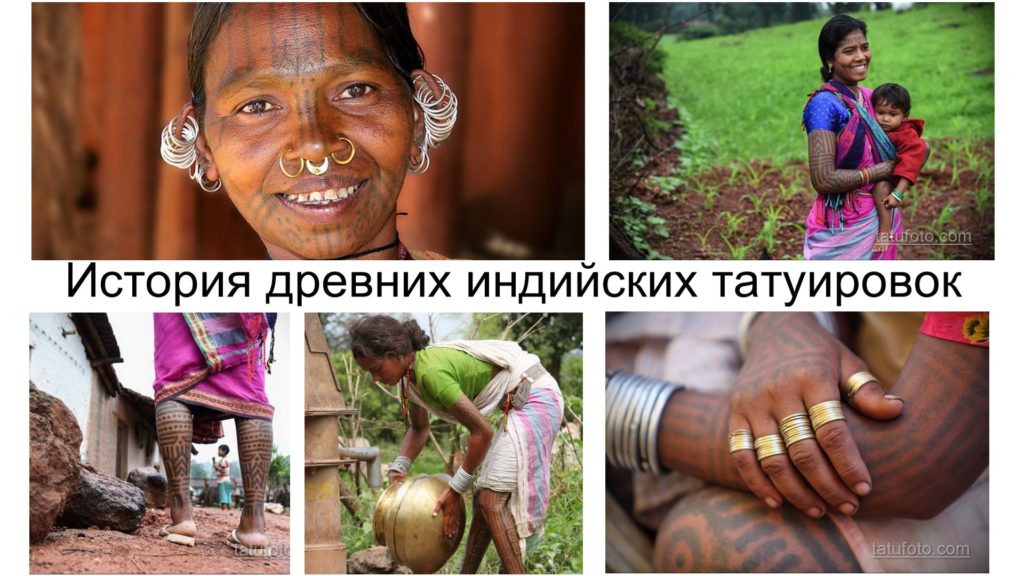History of ancient Indian tattoos
Tattoos have existed in India since ancient times as a sign of social status. But the question of how many years this custom has existed remains a mystery. From the rain-drenched mountain jungles of northeastern India to the dry deserts of Ranna Katcha in the far west, tattoos have not always been considered a mere adornment of the human body; they were used for different reasons, by different societies across the country.

History of ancient Indian tattoos – information about features and photo examples of tattoo designs
History of ancient Indian tattoos – interesting facts
For hundreds of years, the tattooing tradition has been revered throughout India. Ancient cave drawings on prehistoric rocks were transferred by tribal inhabitants to their own bodies. They called this process “gudna” (“burial of a needle” in Hindi) and designated the tattoo as a special precious decoration that no one could take from them, even if they lost all their worldly possessions..

Apatani tribe tattoos
Most of the Indian tattooed tribes lived in remote areas of the country where the kidnapping of women by rival tribes was common..
For example, in the Apatani tribe, girls were tattooed to make them unattractive to rival tribes from neighboring areas who might otherwise have abducted the most beautiful women..
The Apatani tattooing procedure involved the use of thorns to carve out skin and soot, which was mixed with animal fat to create a deep blue color. The wounds were then infected to make the tattoos larger, darker and clearer. In the 1970s, the Indian government banned the procedure, but the practice persisted in some unspoiled places in the northeast..

Singho tribes of Assam and Arunachala, Konyaki, Tod
The other tribe, Singho Assam and Arunachala, had different rules for each gender. Married women got tattooed on both legs from ankles to knees, and men got their hands tattooed. Unmarried girls were forbidden to apply tattoos.
Also among the tattooed tribes of the northeast were the Konyaki hunter tribes of Nagaland who tattooed their faces to indicate their prowess in battle. The tattoos also helped in establishing tribal identity in the region, and it also made it possible to identify bodies after death as a result of war..
Body painting was very common among the warlike tribes of the northeast (including Noth and Wancho Arunachala) as they viewed tattoos as a sign of strength, courage and tolerance for the pain associated with the tattooing process..
Among the Tod tribe in South India, the arms, body and legs were tattooed with the same geometric designs that were used in their embroidery..

Central Indian tattoos
Central India also has a long and barbaric tattoo tradition. Dhanukas in Bihar believe that tattoos disorient women – this helps them avoid the eyes of powerful sex predators. Due to the predominance of purda among women from the lower castes, tattoos had to be visible on the exposed parts of their bodies to warn of their inferior status..
On the other hand, the Munda tribe in Jharkhand, which values courage, uses body art to record historical events. Munda defeated the Mongols three times and to celebrate these victories, the people of Munda even today tattoo three straight vertical lines on their foreheads..
The Gondas in Central India, one of the largest tribes, traditionally left most of their bodies without tattoos. Bare skin was covered with henna (tattoo paint).

The women of the Kutia Kond tribe of Orissa, called the “people of the spirit world”, adorn themselves with beautiful geometric facial tattoos; these identification marks are said to ensure that they recognize each other when they enter the spirit world.
The Santhala and Jharkhand tribes have different tattoos for each gender, for different parts of the body and for different stages of life. Men get tattoos called shikkas on their forearms and wrists, so named because they usually represent the size of coins called shikkas in the Santhal dialect. The number of these tattoos is always different, because odd numbers mean life, and even ones symbolize death in the cosmology of Santhal..

Floral patterns are painstakingly decorated on the bodies of the women of Santhal, including their faces. It is believed that a painful experience prepares a girl for motherhood and gives her the strength to face challenges in life. For example, chati godai is a tattoo inscribed on a woman’s chest when she reaches puberty or when she gets married. Upon completion, the tattoo is rinsed with soapy water to cool it down and reduce pain.
While body art has been practiced for centuries in many Indian communities, it is only in the past few decades that tattoos have become a fashion trend among urban Indian youth. Tribal adaptations of popular designs such as dragon, tiger, and abstract art are gaining popularity among young people. Memorial tattoos that will commemorate the death of a beloved pet, religious tattoos and tattoos with the name of an important person are also very popular..

Over the centuries, Indian body art has undergone great changes – from tattoos in honor of beauty and tradition, to tattoos in honor of fashion and beliefs. Combined with creativity and fashion, tattoos no longer just tell us about a person’s belonging to a territory or tribe. In the modern world, they have become a way of expressing beliefs, memories and phases of human life..
History of ancient Indian tattoos – photo examples from 22, 11, 2019:





















Watch the video:
Prepared by: TEXT_EXP
